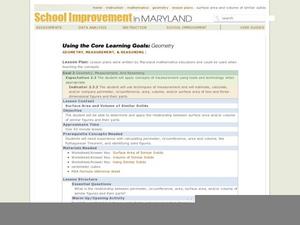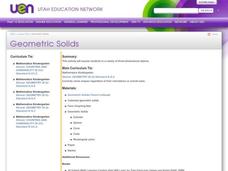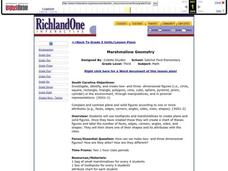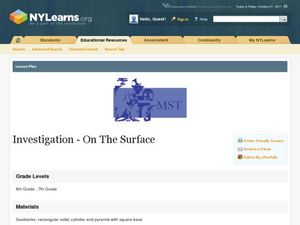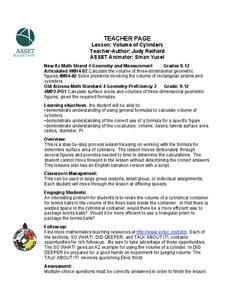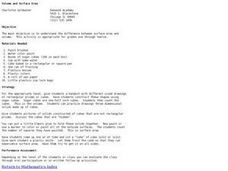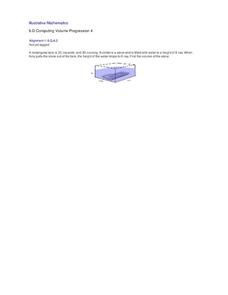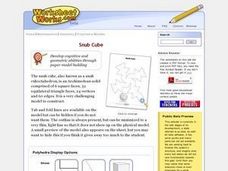Curated OER
Surface Area and Volume of Similar Solids
Young scholars explore similar figures. In this surface area and volume lesson, students identify the relationship between the surface area and volume of similar figures.
Curated OER
Geometric Solids
Students identify and create simple geometric shapes and describe simple spatial relationships. Through discussion, hands-on activities and show and tell, they identify geometric solids in real life and create graphs of commonly found...
Curated OER
Plane and Solid Figures
Students define a plane and a solid shape. In this geometry lesson, students compare and contrast different geometric shapes as they relate to solids. They name the geometric solids based on their sides and edges.
Curated OER
Garden Variety Geometry
Learners prepare to take the GED by reviewing basic math concepts. In this geometry lesson, students review vocabularies such as formula, perimeter, circumference and other important geometric terms. They convert between the English and...
Curated OER
Marshmallow Geometry
Third graders create 2D and 3D shapes using marshmallows and toothpicks. In this geometry lesson, 3rd graders create their shapes and document the number of faces, edges, corners, angles, and sides. They share one shape and its...
Curated OER
Volume of Rectangular Prisms: Algebra/Geometry Institute Summer 2009
Students find the volume of rectangular prisms. In this volume lesson, students use a formula to find the volume of rectangular prisms. They discuss the definition of volume and draw rectangular prisms. Students identify the parts of...
Curated OER
Geometry Skills: Solid and Plane Figures
In this geometry skills worksheet, students respond to 4 questions that require them to examine geometric figures and change them to solid figures and plane figures.
Curated OER
Three Dimensional Solids
In this geometry worksheet, 6th graders examine 3 isometric drawings and match them to 3 three-dimensional solids. They draw the front, side, and top views of 3 three dimensional solids by depicting the unit cubes that were used.
EngageNY
The Volume of Prisms and Cylinders and Cavalieri’s Principle
Young mathematicians examine area of different figures with the same cross-sectional lengths and work up to volumes of 3D figures with the same cross-sectional areas. The instruction and the exercises stress that the two figures do not...
Curated OER
Blind-Sided
Young scholars conduct an experiment. In this geometry lesson, students practice identifying, describing and comparing geometric solids.
Illustrative Mathematics
3-D Shape Sort
From the apple on your desk and the coffee cup in your hand, to the cabinets along the classroom wall, basic three-dimensional shapes are found everywhere in the world around us. Introduce young mathematicians to the these common figures...
CK-12 Foundation
Volume by Cross Section: Volume of the Cone
Discover another way to find the volume of a cone. Pupils explore how the area of a cross section changes as it moves through a cone. The interactive uses that knowledge to develop the integral to use to find the volume of the cone....
Curated OER
Geometry: Tessellations
Students create tessellations with computer software while applying their knowledge of reflections, rotations, and translations.
Curated OER
Poly-Mania
This hands-on lesson takes young geometers on a tour of 2D polygons and 3D polyhedrons. After exploring different web resources and discussing geometric shapes, small groups construct models of polyhedrons using bendable straws. Note:...
Curated OER
3-D Cubes
Pupils investigate cubes. For this geometric solids lesson, students review geometric concepts previously taught, then logon to a computer game in which they find cube figures and identify the shadow of hidden cubes.
Curated OER
Investigation- On The Surface
Students will examine solids to determine which has the least surface area. They will also understand the use of units, square units, and cubic units. There is also the teaching and application of geometry formulas to perform calculations.
Curated OER
Circles 1, 2, 3, 4
Here is a way to help your charges identify circles and spheres. In this shapes geometry and technology instructional activity, students identify and draw circles and explain the related attributes. They recognize circles and spheres...
Curated OER
Volume of Cylinders
Middle and high schoolers calculate the volume of cylinders. In this geometry lesson plan, learners differentiate between rectangular prisms and cylinders. They use the correct formula to solve for each solid.
PBS
Surface Area and Volume
You and your class will like this lesson plan on using visual models to relate the volume and surface area of solid shapes. Learners construct three-dimensional forms using nets. They calculate the surface area and volume for each and...
Curated OER
Volume and Surface Area, A Sweet Activity
Geometry.... sweet! Using sugar cubes, learners build rectangular prisms of different sizes and shapes. They glue them together and assess volume. Then they color the outer sides to visualize and compute surface area. To make a visceral...
Curated OER
Making and Describing Shapes
Explore the concept of creating and describing 2D and 3D shapes. Using geometry your scholars will describe the attributes of shapes and their properties. They explore and discover what happens when you combine shapes and then take...
Illustrative Mathematics
Computing Volume Progression 4
This resource was written for the younger math learner, but finding the volume of an irregular solid is also a problem for algebra and geometry students. Based on Archimedes’ Principle, one can calculate the volume of a stone by...
Curated OER
Volume and Surface Area
Students explore volume and surface area. In this math lesson, students fill boxes with cubes to identify the volume of the boxes. Students discuss area.
Curated OER
Snub Cube
In this math activity, middle schoolers create a paper model of a snub cube. It is an Archimedean solid comprised of 6 square faces, 32 equilateral triangle faces, 24 vertices and 60 edges.


